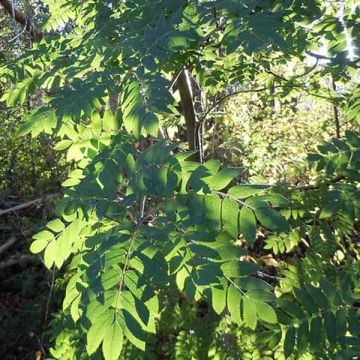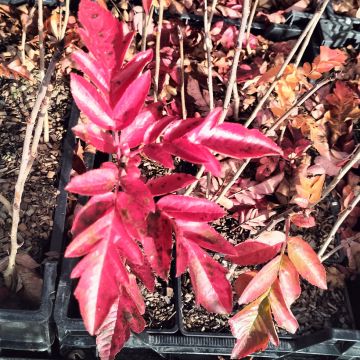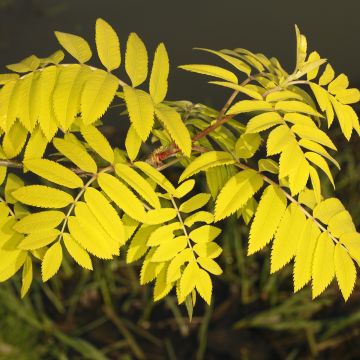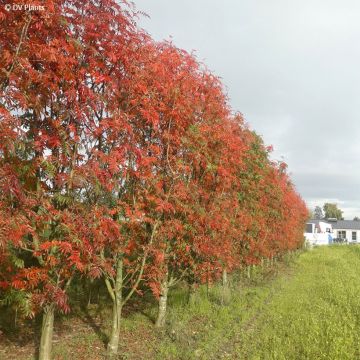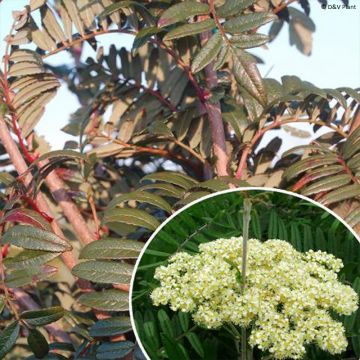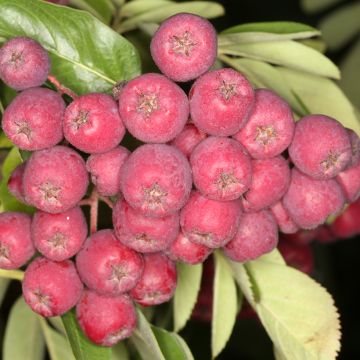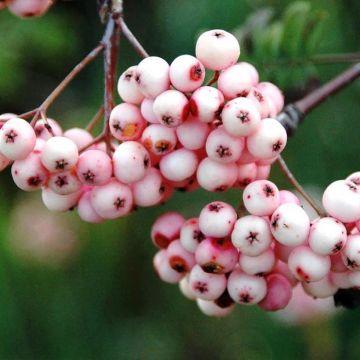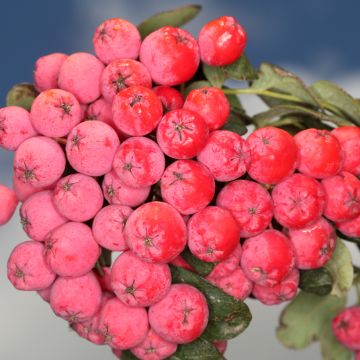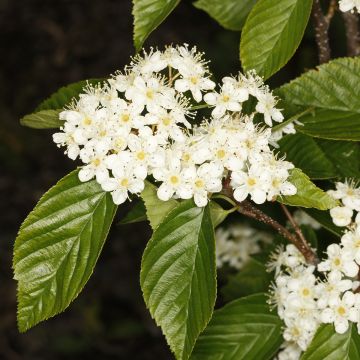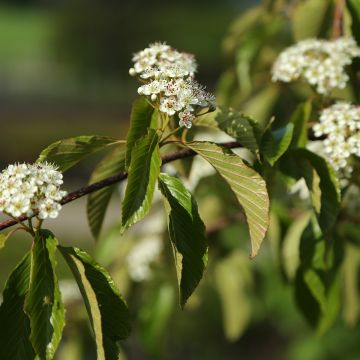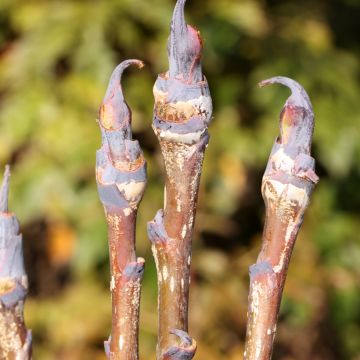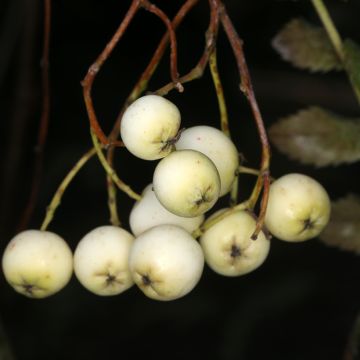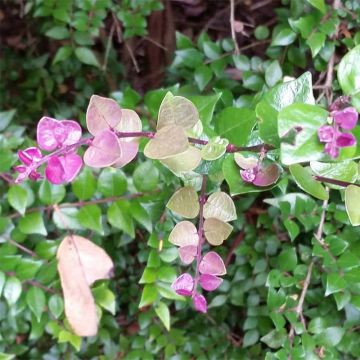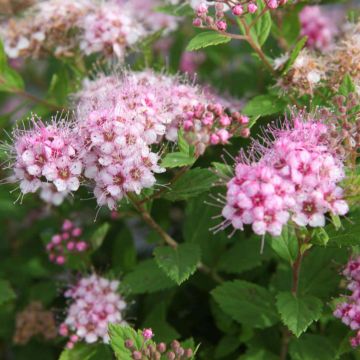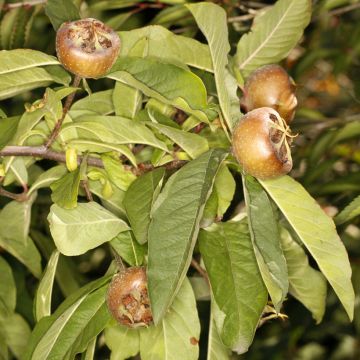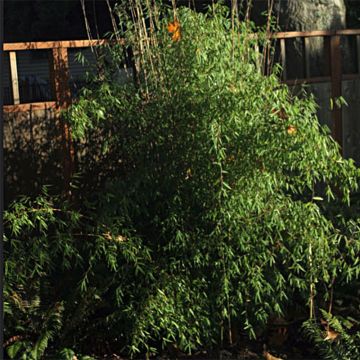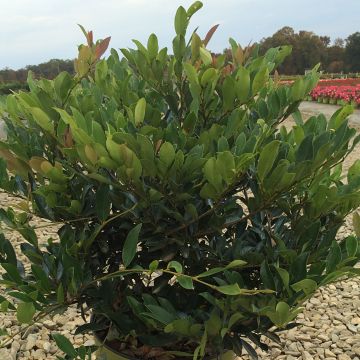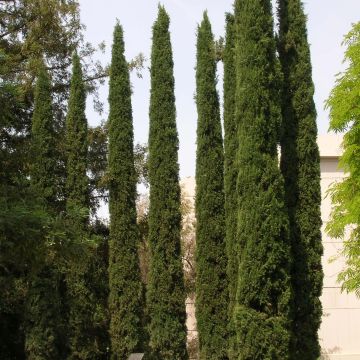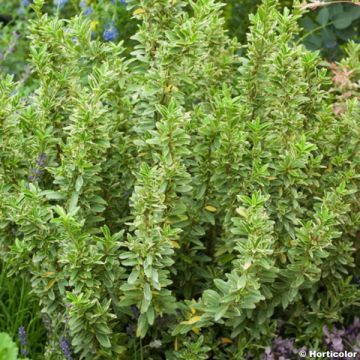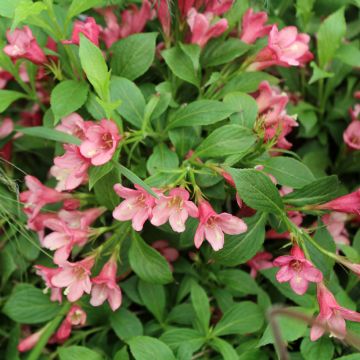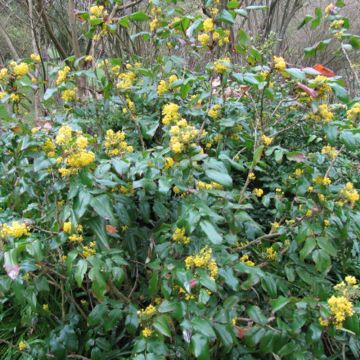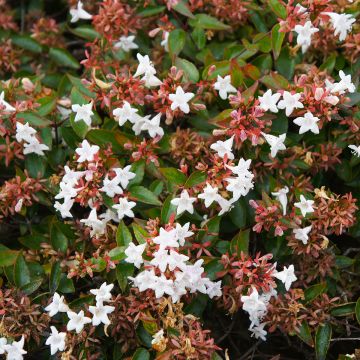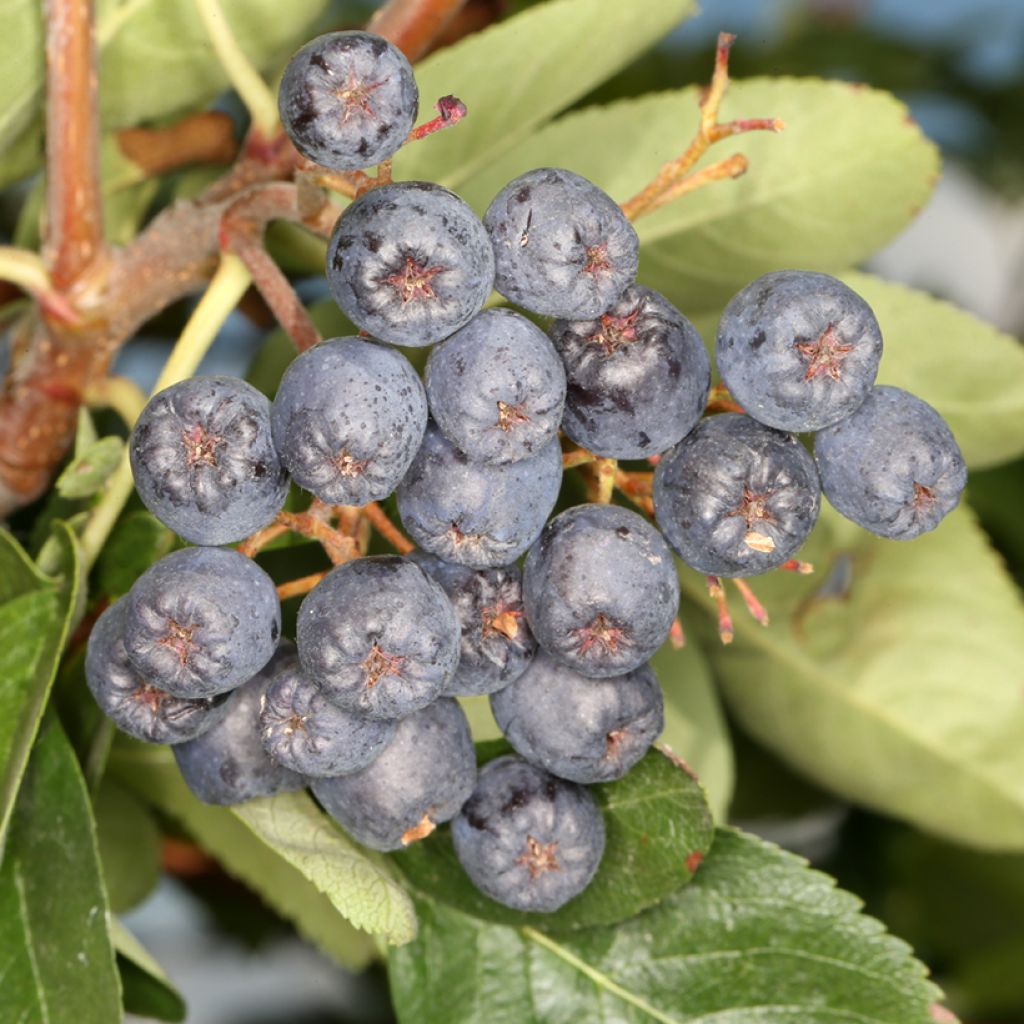

Sorbus aucuparia Black Ruby - Rowan
Sorbus aucuparia Black Ruby - Rowan
Sorbus x aucuparia Black Ruby 'Czarne Rubiny'
Rowan, Mountain Ash, European Rowan
Why not try an alternative variety in stock?
View all →This plant carries a 24 months recovery warranty
More information
We guarantee the quality of our plants for a full growing cycle, and will replace at our expense any plant that fails to recover under normal climatic and planting conditions.
Oversize package: home delivery by special carrier from €6.90 per order..
Express home delivery from €8.90.
Does this plant fit my garden?
Set up your Plantfit profile →
Description
Sorbus Black Ruby 'Czarne Rubiny', derived from the rowan tree (Sorbus aucuparia), is a large deciduous bush appreciated for its autumn colours and edible blue fruits, which have a sweet flavour and no bitterness. It is not demanding regarding soil, very hardy, and makes an excellent free-standing hedge plant that can also be welcomed in a small garden.
Sorbus 'Black Ruby' 'Czarne Rubiny' belongs to the rose family, like all rowans. Originating from Poland, this cultivar is primarily cultivated for its ornamental qualities and edible fruits. It is a small tree with a bushy habit, of vigorous growth, that can reach a height of 2.5 m with a spread of 2 m. Its young branches are upright, dark brown, slightly hairy, while the older branches turn yellowish-grey or grey. Its deciduous compound leaves, consisting of 9 to 11 ovate or lanceolate leaflets, are dark green and glossy on top, lighter and smooth underneath. They turn red in autumn before falling. The winter buds, almost black and sticky, are quite decorative. In June, the bush is covered with reddish or white flowers, grouped in inflorescences 4 to 5 cm wide, each flower measuring 12 to 15 mm in diameter. The ellipsoid to spherical fruits measure 1 to 1.2 cm in diameter and have a slight layer of bloom. They are grouped in generous clusters.
The Black Ruby rowan 'Czarne Rubiny' is perfect in an informal edible hedge or in a shrub border. Its frost resistance and tolerance to various types of soil make it an easy bush to grow. It pairs particularly well with low-maintenance bushes such as Viburnum lantana (Wayfaring tree), Ribes sanguineum 'Red Bross' (Flowering currant), Sambucus nigra (Black elder), and Chaenomeles japonica 'Cido' (Japanese quince).
Report an error about the product description
Plant habit
Flowering
Foliage
Botanical data
Sorbus
x aucuparia
Black Ruby 'Czarne Rubiny'
Rosaceae
Rowan, Mountain Ash, European Rowan
Sorbus Black Ruby
Eastern Europe
Other Sorbus - Mountain Ash
Planting and care
Sorbus 'Black Ruby Czarne Rubiny' is best planted in autumn in rather loamy, moist to slightly dry, acidic, neutral, or calcareous soil. However, it is a tolerant bush that adapts well to ordinary garden soil that is well-tilled. It will thrive in both full sun and partial shade. This small tree has no particular requirements. Remove dead wood or diseased branches. At the end of winter and before new growth begins, prune the crossing inner branches and keep only the vigorous branches to maintain the good habit of the tree.
Mites, aphids, and scale insects are the main enemies of the rowan. Powdery mildew and sooty mould, of fungal origin, can also affect this tree. A preventative treatment with Bordeaux mixture will be sufficient.
Planting period
Intended location
Care
This item has not been reviewed yet - be the first to leave a review about it.
Hedge shrubs
Haven't found what you were looking for?
Hardiness is the lowest winter temperature a plant can endure without suffering serious damage or even dying. However, hardiness is affected by location (a sheltered area, such as a patio), protection (winter cover) and soil type (hardiness is improved by well-drained soil).

Photo Sharing Terms & Conditions
In order to encourage gardeners to interact and share their experiences, Promesse de fleurs offers various media enabling content to be uploaded onto its Site - in particular via the ‘Photo sharing’ module.
The User agrees to refrain from:
- Posting any content that is illegal, prejudicial, insulting, racist, inciteful to hatred, revisionist, contrary to public decency, that infringes on privacy or on the privacy rights of third parties, in particular the publicity rights of persons and goods, intellectual property rights, or the right to privacy.
- Submitting content on behalf of a third party;
- Impersonate the identity of a third party and/or publish any personal information about a third party;
In general, the User undertakes to refrain from any unethical behaviour.
All Content (in particular text, comments, files, images, photos, videos, creative works, etc.), which may be subject to property or intellectual property rights, image or other private rights, shall remain the property of the User, subject to the limited rights granted by the terms of the licence granted by Promesse de fleurs as stated below. Users are at liberty to publish or not to publish such Content on the Site, notably via the ‘Photo Sharing’ facility, and accept that this Content shall be made public and freely accessible, notably on the Internet.
Users further acknowledge, undertake to have ,and guarantee that they hold all necessary rights and permissions to publish such material on the Site, in particular with regard to the legislation in force pertaining to any privacy, property, intellectual property, image, or contractual rights, or rights of any other nature. By publishing such Content on the Site, Users acknowledge accepting full liability as publishers of the Content within the meaning of the law, and grant Promesse de fleurs, free of charge, an inclusive, worldwide licence for the said Content for the entire duration of its publication, including all reproduction, representation, up/downloading, displaying, performing, transmission, and storage rights.
Users also grant permission for their name to be linked to the Content and accept that this link may not always be made available.
By engaging in posting material, Users consent to their Content becoming automatically accessible on the Internet, in particular on other sites and/or blogs and/or web pages of the Promesse de fleurs site, including in particular social pages and the Promesse de fleurs catalogue.
Users may secure the removal of entrusted content free of charge by issuing a simple request via our contact form.
The flowering period indicated on our website applies to countries and regions located in USDA zone 8 (France, the United Kingdom, Ireland, the Netherlands, etc.)
It will vary according to where you live:
- In zones 9 to 10 (Italy, Spain, Greece, etc.), flowering will occur about 2 to 4 weeks earlier.
- In zones 6 to 7 (Germany, Poland, Slovenia, and lower mountainous regions), flowering will be delayed by 2 to 3 weeks.
- In zone 5 (Central Europe, Scandinavia), blooming will be delayed by 3 to 5 weeks.
In temperate climates, pruning of spring-flowering shrubs (forsythia, spireas, etc.) should be done just after flowering.
Pruning of summer-flowering shrubs (Indian Lilac, Perovskia, etc.) can be done in winter or spring.
In cold regions as well as with frost-sensitive plants, avoid pruning too early when severe frosts may still occur.
The planting period indicated on our website applies to countries and regions located in USDA zone 8 (France, United Kingdom, Ireland, Netherlands).
It will vary according to where you live:
- In Mediterranean zones (Marseille, Madrid, Milan, etc.), autumn and winter are the best planting periods.
- In continental zones (Strasbourg, Munich, Vienna, etc.), delay planting by 2 to 3 weeks in spring and bring it forward by 2 to 4 weeks in autumn.
- In mountainous regions (the Alps, Pyrenees, Carpathians, etc.), it is best to plant in late spring (May-June) or late summer (August-September).
The harvesting period indicated on our website applies to countries and regions in USDA zone 8 (France, England, Ireland, the Netherlands).
In colder areas (Scandinavia, Poland, Austria...) fruit and vegetable harvests are likely to be delayed by 3-4 weeks.
In warmer areas (Italy, Spain, Greece, etc.), harvesting will probably take place earlier, depending on weather conditions.
The sowing periods indicated on our website apply to countries and regions within USDA Zone 8 (France, UK, Ireland, Netherlands).
In colder areas (Scandinavia, Poland, Austria...), delay any outdoor sowing by 3-4 weeks, or sow under glass.
In warmer climes (Italy, Spain, Greece, etc.), bring outdoor sowing forward by a few weeks.

































